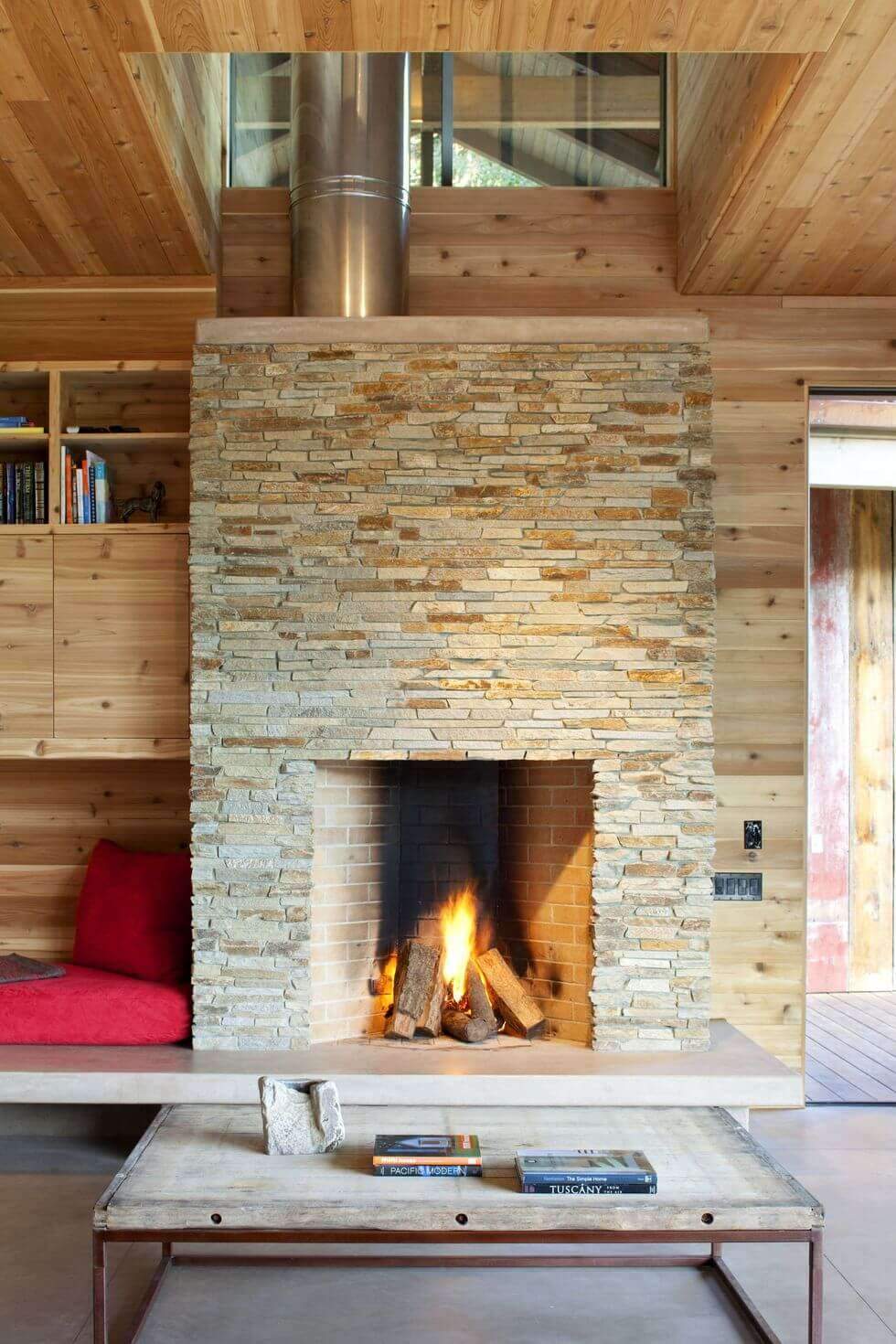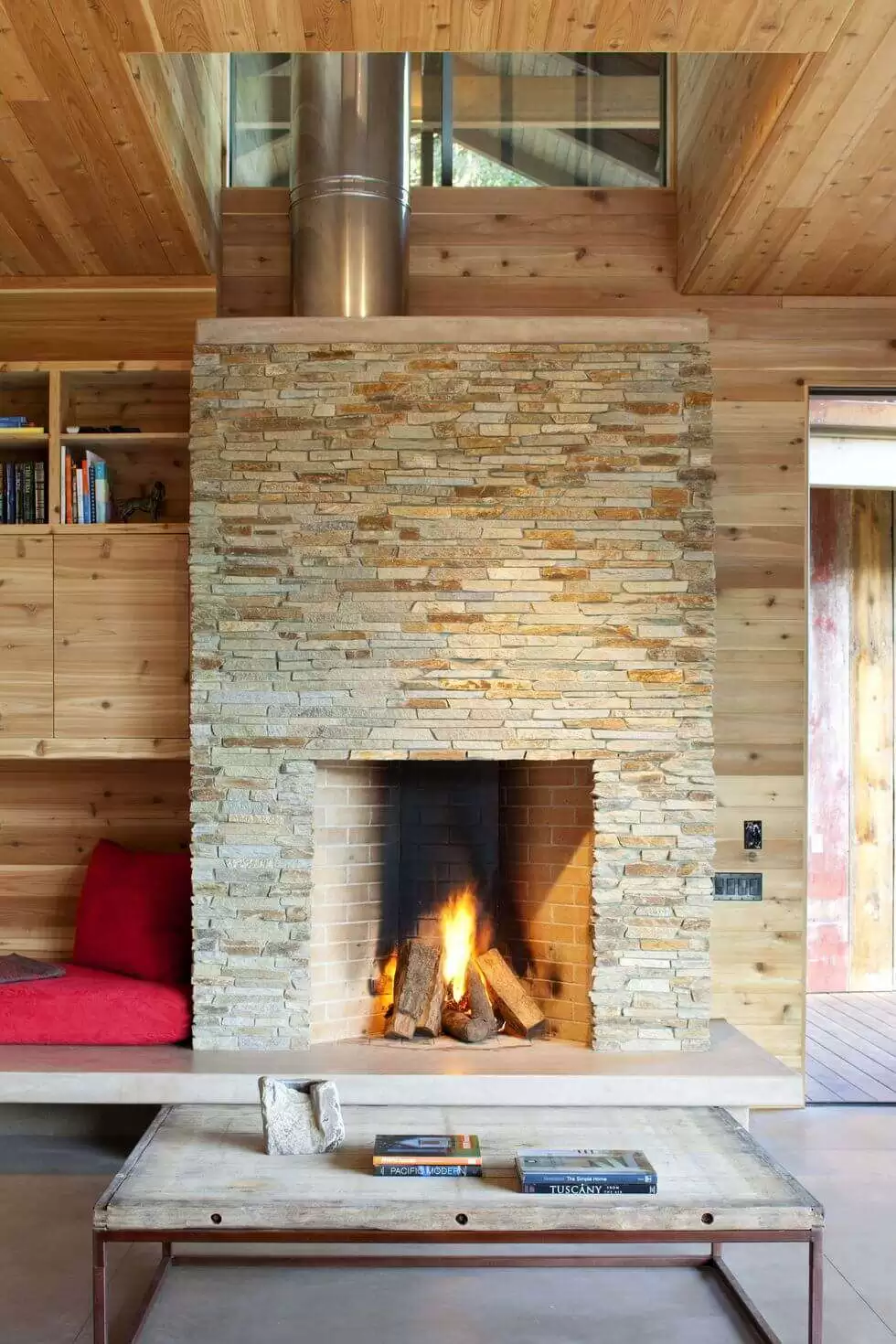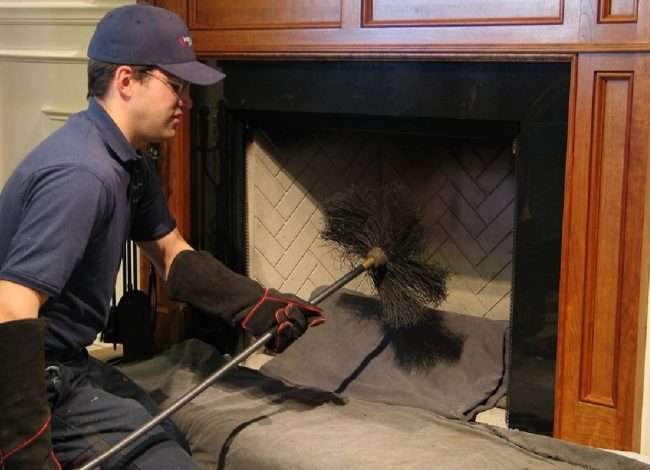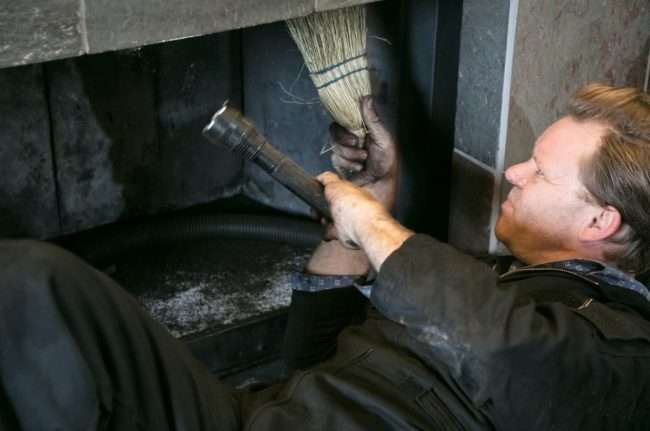A well-maintained brick chimney is essential to the safety and efficiency of your home.
Not only does regular chimney maintenance help protect your home from smoke,
heat, and fire; it can also save you money in the long run by preventing costly repairs and replacements.
This article will provide a comprehensive overview of chimney maintenance,
why it is important, and steps you can take to properly maintain your brick chimney for maximum efficiency.

The importance of maintaining a brick chimney
A brick chimney is an efficient and attractive feature that serves many purposes in a home.
Maintaining a brick chimney is important for safety and aesthetics, and can provide many additional benefits for the home.
First, a well-maintained brick chimney can improve the efficiency and performance of a home’s heating system.
When the chimney is serviced regularly, the chimney liner and exterior masonry will remain free of soot and other debris.
This allows heat to travel up the chimney rather than being blocked by an obstruction.
Moreover, the chimney can provide additional draft and increase the efficiency of the stove.
Second, a brick chimney can provide an extra layer of protection to the interior of the home.
Brick is a strong and durable material that can help keep wind, rain and snow out of your home.
Furthermore, bricks can provide an extra layer of insulation,
helping to keep a home warm and comfortable during the colder months.
Third, well-maintained brick chimneys can help reduce the risk of chimney fires.
Chimney fires are a real danger and can cause serious damage to a home, inside and out.
Creosote particles and other combustible materials can be removed before they build up and cause a serious fire,
with regular chimney inspection and cleaning.
Fourth, maintaining a brick chimney can help preserve and protect the home’s masonry.
As brick is a strong material but it is still subject to damage if it is not maintained properly.
When brick and mortar joints are sealed and checked regularly,
masonry will remain structurally sound for longer and will not need to be replaced as often.
In conclusion, maintaining a brick chimney can provide a number of tangible benefits to the home.
Regular maintenance can improve a home’s heating system, providing an extra layer of protection.
They reduce the risk of chimney fires, and help preserve home construction.
As such, it is essential to ensure that your brick chimney is properly inspected and maintained.

Preventive maintenance
Preventive maintenance is essential to maintaining your brick chimney to maximize efficiency to extend its life and reduce repair-related costs.
Taking the time to have your chimney checked and maintained annually can save you time and money in the long run.
Here are some important tips for keeping your chimney in top condition.
First and foremost, have your chimney checked annually with a qualified chimney sweep.
This professional can identify potential problems, such as leaks, cracks, or mortar damage, and treat them promptly,
preventing more serious damage.
Annual inspections also include chimney sweeps, which help remove creosote,
a combustible substance that forms when wood burns.
And too much creosote buildup can lead to chimney fires, so it’s important to keep up with regular cleanings.
Aside from regular inspections, it can be helpful to look for any visible signs of damage on the outside of the chimney.
Cracks or collapsed brickwork are potential signs of a structural problem that a qualified contractor can easily fix.
Additionally, most chimneys have a cap near the top to keep out animals and debris.
And you can check to make sure your condition is in good shape and is not worsening with age and weather.
It is also important to routinely check the inside of the chimney for damage and debris.
Have someone check the chimney for signs of water damage, birds and other animals, and obstructions.
If you find any of these problems, have a professional chimney sweep address them immediately.
Finally, it is important to regularly check the area around the chimney for any potential hazards.
Make sure there is nothing too close to the chimney that could start a fire.
For example, plants, wood, and other combustible materials are all potential hazards,
so keep them at least three feet away from the chimney.
And these tips can help you maintain your brick chimney for maximum efficiency.
Also, regular maintenance and inspections are essential to a safe and efficient chimney.
Remember to have a qualified professional check and clean your chimney annually to ensure it is always in good condition.

Chimney cleaning
Brick chimney cleaning ensures maximum efficiency and prevents potential damage or fire.
To maintain a brick chimney, it is important to remove soot, creosote, and other debris that can build up over time.
This can be done in several ways:
Step one: Inspect the chimney for any damage or cracks
It is best to do this once a year or after strong storms.
Once cracked or damaged bricks are discovered, these problems must be addressed as soon as possible.
Next step: prepare the chimney for cleaning
Start by covering any furniture, carpeting, and other items near the chimney to protect them from dirt, dust,
and debris that may come up during the cleaning process.
Next, set up ladders or scaffolding to reach the top of the chimney and stock up on the necessary tools.
Finally, take safety measures to protect yourself from any debris or other hazards associated with the process.
While many products are available to aid in the cleaning process, manual cleaning is often the most effective.
Start by using a brush to brush the chimney from top to bottom.
And be sure to get into all the crevices with a small brush or wire brush.
Once the debris has been removed from the outside of the chimney,
you can sweep the inside with a professional vacuum or other type of vacuum cleaner.
This will help remove any leftover residue and creosote that may have been lost during the washing process.
After cleaning your brick chimney, it is important to inspect it to make sure it is still in good condition.
Also, look for any loose bricks or signs of damage and repair or replace them to ensure your chimney remains safe and efficient.
Regular cleaning of a brick chimney is an essential part of chimney maintenance,
and is essential to ensuring optimum efficiency and preventing damage or potential fires.
Inspecting the chimney and taking appropriate safety measures before the operation begins is also important to ensure the job is performed correctly and safely.

Reset bricks
Chimney reconfiguration is an essential step in maintaining its efficiency and structural integrity.
This process involves removing the mortar between the bricks and then re-installing the new mortar with a trowel and mortar bag.
To complete this task safely and correctly, a few steps must be taken beforehand to prepare the chimney and worksite.
First, it is important to protect the surrounding area to avoid accidental damage to other areas.
This can be done by covering the surrounding area with plastic sheeting or tarps and securing it with duct tape.
Before work begins, it is also important to remove any debris and vegetation surrounding the chimney.
Then, the old mortar must be removed before any new mortar can be applied.
This can be done by chipping the mortar manually with a cold chisel and hammer or by using a power tool,
such as a rotary hammer or demolition hammer.
If a power tool is used, it is important to take safety precautions, such as wearing safety glasses and a dust mask.
Once the old mortar has been removed, it is time to mix the new mortar for re-painting.
This can be done with a mortar mixer or a hose and a bucket of water.
The mortar should also be mixed into a paste of the consistency of peanut butter.
After mixing the mortar, it is important to roll it into the joints before it begins to dry.
Finally, once the brickwork has been successfully reconfigured and the mortar has had a chance to fully cure,
It is important to seal brick and mortar joints with a high quality sealant.
This will help prevent moisture and other elements from seeping into and damaging the brickwork.
Brick chimney reconfiguration is essential to maintaining its efficiency and long-term structural integrity.
By following these steps, the homeowner or contractor can complete this task safely and correctly,
ensuring that the chimney will remain in good condition for years to come.

Check the chimney lining
When servicing a brick chimney, it is essential to inspect the flue liner regularly.
The flue liner is a component of the chimney that helps provide a safe passage for smoke and combustion by-products that are released from the home.
Without this component, smoke could escape into living areas and cause potential health risks and safety issues.
When checking a chimney liner, there are several steps that must be taken to ensure that it is working properly.
The first is to check the condition of the liner itself:
look for any signs of cracks, holes, or deterioration.
And if any are present, they should be addressed as soon as possible.
Secondly, check the connection points between the chimney lining and the chimney:
Make sure that the connections are secure and that air cannot leak through them,
because this will reduce the efficiency of the chimney.
Third, check the flue size:
The ideal flue size depends on the type of fuel used for the stove.
But the chimney must be at least 8 inches in diameter for a wood stove.
If the flue is too small, it will slow the movement of smoke and increase the risk of smoke entering the home.
Once the stack has been sized, it is important to clean the stack and remove any debris,
soot, or other deposits that may have built up inside the stack. This can be done with a chimney brush,
Or it may be necessary to hire a professional chimney sweep to do the job.
Once the chimneys have been cleaned, it is also important to check the mortar joints and make sure they are not cracked or crumbling.
Finally, check the chimney hood and make sure it is in good condition and in its secure location.
The cap is important in keeping the chimney free of debris and the elements while also helping to prevent the buildup of creosote deposits.
When done correctly, a chimney liner check can not only help ensure your chimney is operating safely and efficiently,
It also helps prevent more costly repairs in the future.

Repair and replace damaged components
Maintaining a brick chimney is essential to optimal performance of your fireplace or wood-burning stove.
And the regular inspection and maintenance of the chimney can ensure the safe use and efficient operation.
As brick chimneys age, they can experience wear and tear that can reduce performance or cause hazards.
Here are some steps you can take to repair and replace damaged components of your brick chimney:
First you need to inspect the chimney and identify any damaged components,
look for cracked or chipped mortar joints,
Loose or missing bricks or other signs of deterioration.
Minor damage can often be repaired with a few simple tools and materials.
In the event of significant damage or damage to the interior of the chimney,
you may need to contact a professional surveyor or construction technician to repair or replace the required components.
Once you identify the damaged component, you can repair or replace it.
For minor damage, such as chipped mortar joints, you will need to clean up the old mortar and apply new mortar to the joint.
When applying the new mortar, use a trowel and work it into the seams until the joint is sealed tightly.
If you need to replace more basic components such as bricks or mortar, you may need to hire a professional.
A professional building contractor can also customize and install new brick to match the existing chimney.
They should also ensure proper installation of new mortar and sealant to secure the brickwork and improve the overall efficiency of the chimney.
Finally, it is helpful to cover any exposed brickwork with a waterproof sealant.
This will help protect the brick from moisture, dirt and other harmful factors.
You should regularly check your chimney for signs of damage, and if any, take steps to repair or replace components.
Taking these steps will help extend the life of your brick chimney and maintain optimal performance.

Replacement of damaged mortar joints
Replacing damaged mortar joints is an important part of maintaining a brick chimney for maximum efficiency.
Mortar is a cement-based material used to bind bricks together and isolate any gaps between them.
Mortar can deteriorate over time due to weathering, improper installation, or damage from animals or pests.
When mortar joints become damaged, it is important to replace them as soon as possible
to ensure the structural integrity of the chimney and to protect against water and other contaminants.
The first step in replacing damaged mortar joints is to inspect the chimney and identify damaged areas.
Look for areas where the mortar has eroded or been eaten by animals or insects.
Once any damaged areas have been identified, the next step is to remove the old mortar.
This is usually done by removing the old mortar using a chisel and a small hammer,
and care must be taken not to damage the bricks in the process.
Once the old mortar has been removed, the area must be cleaned and any loose debris removed before the new mortar can be used.
The new mortar must be mixed with water until it has a thick consistency.
Then it must then be applied to the bricks using a trowel.
The mortar must be spread evenly and tightly packed into the gap of the brick to ensure a secure bond.
The slurry should then be allowed to dry and cure for 24-48 hours before further maintenance.
And replacing damaged mortar joints on a brick chimney is important to maintaining the chimney for maximum efficiency.
Care must be taken to check the chimney regularly and to identify and repair any damaged mortar joints as quickly as possible.
With proper maintenance and repair, brick chimneys can last for many years with minimal maintenance.

Repair or replace damaged bricks
When it comes to maintaining a brick chimney, one of the most important tasks is repairing or replacing any damaged bricks.
The structural integrity of a chimney depends greatly on the quality and condition of its bricks,
so it is essential that it be in peak condition.
If you want to ensure your chimney is working properly.
Before attempting any repairs or replacements, you should inspect the chimney and identify any potential problems with the bricks.
Cracks, discoloration, and bulging can indicate problems with the brick, and can also lead to future problems.
Once you’ve identified any damaged areas, it’s important to decide whether to repair or replace the bricks.
In general, small, manageable bricks can be repaired, while large cracks or severely damaged bricks must be replaced.
For brick repair:
- Start by cleaning the area around the damage. You can remove loose debris and dirt with a brush or vacuum.
- Mix up some mortar using the same type of mortar that was used to build the chimney.
- Use a mortar trowel to apply mortar around the edges of the bricks, and then use a brick jointer to press the mortar into the joints.
- Once all of the mortar is in place, allow it to dry completely before moving on to the next step.
Replacing the bricks is more complicated, but is necessary if the bricks are severely damaged or the brick jointer cannot fix the problem.
First, remove the damaged bricks using a cold chisel and hammer, being careful not to damage any surrounding bricks.
Next, use a resting chisel to chip away at the brick until it is removed.
Once you’ve removed the damaged bricks, you’ll need to prepare the area for new bricks.
Start by cleaning the area with a brush or vacuum and remove any grout from the edges.
You will also need to check the level of the area and make sure there is enough room for new brick.
Finally, mix up a new batch of mortar and use a trowel to apply the mortar to the edges of the new bricks.
Carefully place the bricks into the space, making sure they are level and secure.
Also, use a brick jointer to press the mortar into the joints, and then allow it to dry completely before using the chimney.

Install a rain cover or top seal
Installing a rain cap or top seal is one of the most important maintenance tasks to ensure the efficiency of your brick chimney.
Rain caps and top seal dampers protect against the elements, animals, and pests that can enter your chimney stack and cause dangerous blockages.
In addition, these components help prevent the loss of warm air and prevent cold drafts from entering the home.
Installing a rain cover or top seal requires a few simple steps:
First, remove any existing hardware from the chimney crown, such as chimney tiles or a chimney cap.
Next, install the rain cover or top seal in place.
Depending on the type of damper, you may need to drill holes in the cement and secure it with anchors and screws,
or you may need to attach it to the crown using suitable hardware.
It is important to ensure a good fit and a tight seal around the edge of the damper to prevent leakage.
In addition, a silicone sealant can be applied around the circumference of the damper to reduce any potential leaks.
Once the damper is installed, test it to make sure it is working properly and is airtight.
Installing a rain cap or top seal is critical to maintaining a brick chimney for maximum efficiency.
If done properly, this component will protect your chimney from the elements, reduce drafts, and reduce drafts.
It prevents destructive pests from entering the chimney.
The secure seal also encourages safe and efficient airflow through the chimney,
helping to keep your home warm and comfortable.
In short, a brick chimney requires regular maintenance to maintain its structural integrity and efficient operation.
Each component of the chimney must be checked regularly to ensure that everything is in order and that no repairs or replacements are required.
Proper chimney cleaning is also essential to prevent creosote build-up, which can start fires in chimneys.
Reshaping the joints in the chimney can also help keep the chimney in good working order.
In addition, having the chimney inspected and sweeped by a professional can help address potential problems.
By taking all of these steps, you can ensure that your brick chimney remains in good condition and provides efficient and safe operation for many years.
For more architectural news


 العربية
العربية